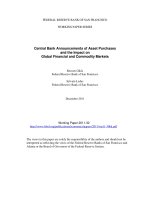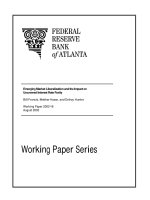Financial accounting the impact on decision makers 9e chapter 11
Bạn đang xem bản rút gọn của tài liệu. Xem và tải ngay bản đầy đủ của tài liệu tại đây (3.27 MB, 60 trang )
Chapter 11
Stockholders’ Equity
Stockholders’ Equity
Stockholders:
Owners
of a corporation
Have a residual interest in assets after liabilities are
satisfied
Stockholders’ equity:
Two major components
Contributed capital
Retained earnings
LO 1
Stockholders’ Equity
Contributed Capital:
Amount
a corporation receives from the sale of
stock (common or preferred) to the stockholders
Additional Paid-In Capital : amount received at
issuance that exceeds the par value of the stock
Retained earnings:
Amount
of net income, over the life of the company
not paid out as dividends
An important link between the income statement
and the balance sheet
EXHIBIT 11.1—Advantages and Disadvantages of
Stock versus Debt Financing
Stockholders’ Equity on the Balance
Sheet
The basic accounting equation:
Assets = Liabilities + Stockholders’ Equity
Two major components or subcategories:
Components of the Stockholders’
Equity Section of the Balance Sheet
Number of Shares
Par Value
Additional Paid-In Capital
Retained Earnings
Contributed Capital
Common stock
Carries
voting rights
The common stockholders elect the corporation’s
officers
• Establish its bylaws and governing rules
Preferred stock
Flexible
and tailored to a company’s needs
Preference in dividends
Number of Shares
Authorized shares: the maximum number of shares a corporation may
issue as indicated in the corporate charter
Issued shares: the number of shares sold or distributed to
stockholders
Outstanding shares: the number of shares issued less the number of
shares held as treasury stock
Par Value
An arbitrary amount that represents the legal capital of the firm
Stated on the face of the stock certificate
Also called “stated value”
Amount presented in the stock account
Additional Paid-In Capital & Retained
Earnings
Additional paid-in capital: the amount received for the issuance of
stock in excess of the par value of the stock
Retained earnings: net income that has been made by the corporation
but not paid out as dividends
Not
necessarily available to stockholders
May be used for purchase of assets, the retirement of
debt, or other financial needs
Exhibit 11.2—Retained Earnings Connects
the Income Statement and the Balance Sheet
IFRS and Stockholders’ Equity
Items that have characteristics of both debt and
equity
International accounting rules
Example: Convertible bond is similar to debt but
because it will become stock if converted, it also has the
characteristics of equity
An item having both debt and equity component should
be separated into two parts—liability and stockholders’
equity
U.S. accounting standards
Do not require to be recorded as a separate amount
Recorded as either liability or stockholders’ equity
Preferred Stock
Flexible and tailored to a company’s needs
Dividends must be distributed to preferred stockholders before
common stockholders
Right to the company’s assets before the common stockholders during
liquidation
The dividend rate may be stated in two ways:
Percentage
of the stock’s par value
Per-share amount
LO 2
Preferred Stock Additional Terms and
Features
Convertible: allows preferred stock to be exchanged for common stock
Redeemable: allows stockholders to sell stock back to the company
Callable: allows the firm to eliminate a class of stock by paying the
stockholders a specified amount
Preferred Stock Additional Terms and
Features
Cumulative: the right to dividends in arrears before the current-year
dividend is distributed
Participating: allows preferred stockholders to share on a percentage
basis in the distribution of an abnormally large dividend
Issuance of Stock
Issued for cash or for noncash assets
When issued for cash:
Par
value reported in the stock account
Amount in excess of par is reported in the Paid-In
Capital account
When exchanged for noncash items:
Recorded
at the fair market value of the stock or the
assets received, whichever is most readily
determined
LO 3
Example 11.1—Recording Stock
Issued for Cash
Assume that on July 1, a firm issued 1,000 shares of $10 par common
stock for $15 per share
Example 11.2—Recording Stock for
Noncash Consideration
Assume that on July 1, a firm issued 500 shares of $10 par
preferred stock to acquire a building. The stock is not widely
traded, and the current market value of the stock is not evident.
The building has recently been appraised by an independent
firm as having a market value of $12,000
Treasury Stock
Represents the corporation’s own stock, previously issued to
shareholders, repurchased from stockholders and not retired,
but held for various purposes
Repurchase is recorded as a debit to Treasury Stock, a contraequity account
For an amount to be treated as treasury stock:
It must be the corporation’s own stock
It must have been issued to the stockholders at some point
It must have been repurchased from the stockholders
It must not be retired, but must be held for some purpose
LO 4
Example 11.3—Recording the Purchase
of Treasury Stock
Assume that the Stockholders’ Equity section of Rezin Company’s
balance sheet on December 31, 2014, appears as follows:
Example 11.3—Recording the Purchase
of Treasury Stock (continued)
Assume that on February 1, 2015, Rezin buys 100 of its shares as
treasury stock at $25 per share.
Stockholders’ Equity Section
The Stockholders’ Equity section of Rezin’s balance sheet on February
1, 2015, after the purchase of the treasury stock
Retirement of Stock
Repurchase of stock with no intention of reissuing
To eliminate a particular class of stock or group of stockholders
The general principle for retirement of stock is the same as for treasury
stock transactions
No income statement accounts are affected
Effect is reflected in the Cash account and the Stockholders’ Equity
accounts
Cash Dividends
Declared only if a company has sufficient cash available and adequate
retained earnings
Not an expense on the income statement
Date of declaration: cash dividends are declared
Payment date: cash dividends are paid
Date of record: dividend is paid to the stockholders who own the stock
as of this date
LO 5
Dividend Payout Ratio
The annual dividend amount divided by the annual net income
RatioDividend
for many firms
is 50%Ratio
or 60%= and seldom exceeds 70%
Payout
Annual Dividend
Annual Net Income









